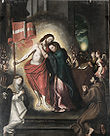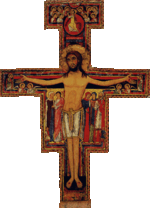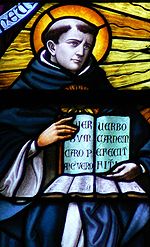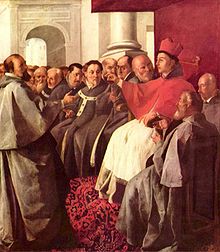- Bonaventure
-
This article is about the Italian medieval theologian. For other uses, see Bonaventure (disambiguation).
Saint Bonaventure, O.F.M. 
Friar, Bishop, Doctor of the Church Born 1221
Bagnoregio, Province of Viterbo, Latium, Papal States (now modern-day Italy)Died July 15, 1274
Lyon, Lyonnais, Kingdom of Arles (now modern-day France)Honored in Roman Catholic Church Canonized April 14, 1482, Rome by Pope Sixtus IV Feast 15 July
2nd Sunday in July (1482–1568)
14 July (1568–1969)Attributes Cardinal's hat on a bush; ciborium; Holy Communion; cardinal in Franciscan robes, usually reading or writing Bonaventure 
Full name Bonaventure Other names "Giovanni di Fidanza" ("John of Fidanza"), "Doctorus Seraphicus" ("Seraphic Doctor") Born 1221
Bagnoregio, Province of Viterbo, Latium Papal States (now Italy)Died 15 July 1274 Era Medieval philosophy Region Western philosophy School Scholasticism Influenced by- Alexander of Hales, Aristotle, Augustinus, Pseudo-Dionysius, Anselm of Canterbury, Avicebron, Stoicism (through Cicero)
Influenced- Nicholas of Cusa among others
A series of articles on
Christian mysticism
Articles
Aspects of meditation • Christian meditation • Contemplative prayer • Hesychasm • Mystical theology • Reflection on the New AgeEarly period
Gregory of Nyssa • Bernard of Clairvaux • Guigo II13th and 14th centuries
Francis of Assisi • Dominic de Guzmán • Bonaventure • Catherine of Siena15th and 16th centuries
Ignatius of Loyola • Francisco de Osuna • John of Avila • Teresa of Avila • John of the Cross17th and 18th centuries
Francis de Sales • Pierre de Bérulle19th century
Therese of Lisieux • Gemma Galgani • Conchita de Armida20th century
Maria Valtorta • Faustina Kowalska • Thomas MertonSaint Bonaventure, O.F.M., (Italian: San Bonaventura; 1221 – 15 July 1274),[1] born John of Fidanza (Italian: Giovanni di Fidanza), was an Italian medieval scholastic theologian and philosopher. The seventh Minister General of the Order of Friars Minor, he was also a Cardinal Bishop of Albano. He was canonized on 14 April 1482 by Pope Sixtus IV and declared a Doctor of the Church in the year 1588 by Pope Sixtus V. He is known as the "Seraphic Doctor" (Latin: Doctor Seraphicus). Many writings believed in the Middle Ages to be his are now collected under the name Pseudo-Bonaventura.
Contents
Life
He was born at Bagnoregio in Latium, not far from Viterbo. Almost nothing is known of his childhood, other than the names of his parents, Giovanni di Fidanza and Maria Ritella.
He entered the Franciscan Order in 1243 and studied at the University of Paris, possibly under Alexander of Hales, and certainly under Alexander's successor, John of Rochelle. In 1253 he held the Franciscan chair at Paris and was proceeded as Master of Theology. Unfortunately for Bonaventure, a dispute between seculars and mendicants delayed his reception as Master until 1257, where his degree was taken in company with Thomas Aquinas.[2] Three years earlier his fame had earned him the position of lecturer on the The Four Books of Sentences—a book of theology written by Peter Lombard in the twelfth century—and in 1255 he received the degree of master, the medieval equivalent of doctor.
After having successfully defended his order against the reproaches of the anti-mendicant party, he was elected Minister General of the Franciscan Order. On 24 November 1265, he was selected for the post of Archbishop of York; however, he was never consecrated and resigned the appointment in October 1266.[3] It was by his order that Roger Bacon, a Franciscan friar himself, was interdicted from lecturing at Oxford and compelled to put himself under the surveillance of the order at Paris.
Bonaventure was instrumental in procuring the election of Pope Gregory X, who rewarded him with the title of Cardinal Bishop of Albano, and insisted on his presence at the great Council of Lyon in 1274. There, after his significant contributions led to a union of the Greek and Latin churches, Bonaventure died suddenly and in suspicious circumstances. The Catholic Encyclopedia has citations which suggest he was poisoned. The only extant relic of the saint is the arm and hand with which he wrote his Commentary on the Sentences, which is now conserved at Bagnoregio, in the parish church of St. Nicholas.
Feast day
Bonaventure's feast day was included in the General Roman Calendar immediately upon his canonization in 1482. It was at first celebrated on the second Sunday in July, but was moved in 1568 to 14 July, since 15 July, the anniversary of his death, was at that time taken up with the feast of Saint Henry. It remained on that date, with the rank of "double", until 1960, when it was reclassified as a feast of the third class. In 1969 it was classified as an obligatory memorial and assigned to the date of his death, 15 July.[4]
Philosophy and works
Bonaventure was formally canonized in 1484 by the Franciscan Pope Sixtus IV, and ranked along with Saint Thomas Aquinas as the greatest of the Doctors of the Church by another Franciscan Pope Sixtus V, in 1587. His works, as arranged in the most recent Critical Edition of his works by the Quaracchi Fathers (Collegio S. Bonaventura), consist of a Commentary on the Sentences of Lombard, in four volumes, and eight other volumes, among which are a Commentary on the Gospel of St Luke and a number of smaller works; the most famous of which are Itinerarium Mentis in Deum, Breviloquium, De Reductione Artium ad Theologiam, Soliloquium, and De septem itineribus aeternitatis, in which most of what is individual in his teaching is contained. Nowadays German philosopher Dieter Hattrup denies that De reductione artium ad theologiam might be written by Bonaventure, claiming that the style of thinking does not match Bonaventure's original style.[5]
In philosophy Bonaventure presents a marked contrast to his contemporaries, Roger Bacon and Thomas Aquinas. While these may be taken as representing, respectively, physical science yet in its infancy, and Aristotelian scholasticism in its most perfect form, he presents the mystical and Platonizing mode of speculation which had already, to some extent, found expression in Hugo and Richard of St. Victor, and in Bernard of Clairvaux. To him, the purely intellectual element, though never absent, is of inferior interest when compared with the living power of the affections or the heart. He used the authority of Aristotle in harmony with Scriptural and Patristic texts, and attributed much of the heretical tendency of the age to the attempt to divorce Aristotelian philosophy from Catholic theology. Like Thomas Aquinas, with whom he shared numerous profound agreements in matters theological and philosophical, he combated the Aristotelian notion of the eternity of the world vigorously. Augustine, who had imported into the west many of the doctrines that would define scholastic philosophy, was an incredibly important source of Bonaventure's Platonism. Another prominent influence was that of a mystic by the name of Dionysius the Areopagite.
Bonaventure accepts the Platonic doctrine that ideas do not exist in rerum natura, but as ideals exemplified by the Divine Being, according to which actual things were formed; and this conception has no slight influence upon his philosophy. Like all the great scholastic doctors he starts with the discussion of the relations between reason and faith. All the sciences are but the handmaids of theology; reason can discover some of the moral truths which form the groundwork of the Christian system, but others it can only receive and apprehend through divine illumination. In order to obtain this illumination, the soul must employ the proper means, which are prayer, the exercise of the virtues, whereby it is rendered fit to accept the divine light, and meditation which may rise even to ecstatic union with God. The supreme end of life is such union, union in contemplation or intellect and in intense absorbing love; but it cannot be entirely reached in this life, and remains as a hope for the future. The mind in contemplating God has three distinct aspects, stages or grades—the senses, giving empirical knowledge of what is without and discerning the traces (vestigia) of the divine in the world; the reason, which examines the soul itself, the image of the divine Being; and lastly, pure intellect (intelligentia), which, in a transcendent act, grasps the Being of the divine cause.
To these three correspond the three kinds of theology: theologia symbolica, theologia propria and theologia mystica. Each stage is subdivided, for in contemplating the outer world we may use the senses or the imagination; we may rise to a knowledge of God per vestigia or in vestigiis. In the first case the three great properties of physical bodies—weight, number, measure—in the second the division of created things into the classes of those that have merely physical existence, those that have life, and those that have thought, irresistibly lead us to conclude the power, wisdom and goodness of the Triune God. So in the second stage we may ascend to the knowledge of God, per imaginem, by reason, or in imagination, by the pure understanding (intellectus); in the one case the triple division—memory, understanding and will,—in the other the Christian virtues—faith, hope and charity,—leading again to the conception of a Trinity of divine qualities—eternity, truth and goodness.
In the last stage we have first intelligentia, pure intellect, contemplating the essential being of God, and finding itself compelled by necessity of thought to hold absolute being as the first notion, for non-being cannot be conceived apart from being, of which it is but the privation. To this notion of absolute being, which is perfect and the greatest of all, objective existence must be ascribed. In its last and highest form of activity the mind rests in the contemplation of the infinite goodness of God, which is apprehended by means of the highest faculty, the apex mentis or synderesis. This spark of the divine illumination is common to all forms of mysticism, but Bonaventura adds to it peculiarly Christian elements. The complete yielding up of mind and heart to God is unattainable without divine grace, and nothing renders us so fit to receive this gift as the meditative and ascetic life of the cloister. The monastic life is the best means of grace.
Bonaventure, however, is not merely a meditative thinker, whose works may form good manuals of devotion; he is a dogmatic theologian of high rank, and on all the disputed questions of scholastic thought, such as universals, matter, the principle of individualism, or the intellectus agens, he gives weighty and well-reasoned decisions. He agrees with Saint Albert the Great in regarding theology as a practical science; its truths, according to his view, are peculiarly adapted to influence the affections. He discusses very carefully the nature and meaning of the divine attributes; considers universals to be the ideal forms pre-existing in the divine mind according to which things were shaped; holds matter to be pure potentiality which receives individual being and determinateness from the formative power of God, acting according to the ideas; and finally maintains that the intellectus agens has no separate existence. On these and on many other points of scholastic philosophy the "Seraphic Doctor" exhibits a combination of subtlety and moderation, which makes his works particularly valuable.
In Islamic thought
St. Bonaventure was widely regarded as one of the greatest Christian theologians by early Muslim thinkers. Hossein Nasr, in his A Young Muslim's Guide to the Modern World mentions Bonaventure amongst the outstanding saints, saying:
St. Bonaventure was one of the greatest theologians and philosophers of Christianity. An Italian Franciscan, he was declared one of the Doctors of the Church and remains to this day as one of the most important authorites on the interpretation of Christian thought among Catholics. He entered the University of Paris where he joined the Franciscan order and studied theology, in which he soon became a notable figure. He is especially well known for his insistence that the pursuit of truth is part of divine worship. He wrote commentaries on the Bible as well as the Sentences of Peter Lombard and was well versed in the philosophies of Augustine of Hippo and Aristotle as well as Islamic philosophy...Saint Bonaventure was also a great mystic and wrote one of the most famous treatises of mysticism in the Middle Ages, The Journey of the Mind to God...
Places, churches, and schools named in his honor
- The town of Bonaventure, Quebec, Canada
- Bonaventure Highway in Quebec
- Place Bonaventure and the adjacent Bonaventure Metro Station in Montreal, Quebec
- Bonaventure Island and the Bonaventure River in the Gaspé Peninsula Region of Quebec
- St. Bonaventure's College, a private Roman Catholic school, in Newfoundland and Labrador, Canada
- St Bonaventure's Catholic Comprehensive School, in Forest Gate, London, England
- The City of Ventura, California, officially named San Buenaventura, the county seat of Ventura County, California, in the United States
- St. Bonaventure University, a Franciscan university, in Allegany, New York
- The Municipality of Buenaventura on the Pacific Coast of Colombia
- The cities of San Benaventura in Chihuahua and San Buenaventura, Coahuila in Mexico and State of San Benaventura
- Barangay San Buenaventura, a village in San Pablo City, Laguna, Philippines. Three small chapels can be found within the village in honor of Saint Bonaventura
- St. Bonaventure's High School, a school in Hyderabad, Pakistan
- St. Bonaventure's Church, a 16th century Portuguese church is situated on the beach in Erangal near Mumbai. The annual Erangal Feast held on second Sunday of January, celebrating the Feast day of St. Bonaventure, attracts thousands of people of all faiths to this scenic spot. The Birthday Of St. Bonaventure is celebrated on the 15th of July every year.
Works
- Life of St Francis of Assisi, TAN Books, 2010. ISBN 9780895551511
- On the Reduction of the Arts to Theology (De Reductione Artium ad Theologiam), Franciscan Institute Publications, 1996. ISBN 978-1-57659-043-0
- Itinerarium Mentis in Deum (Journey of the Soul Into God), (†)Philotheus Boehner, OFM, Franciscan Institute Publications, 2002. ISBN: 978-1-57659-044-7
- Saint Bonaventure’s Disputed Questions on the Mystery of the Trinity, Franciscan Institute Publications,
1979. ISBN 978-1-57659-045-4
References
- ^ M. Walsh, ed (1991). Butler's Lives of the Saints. New York: HarperCollins. p. 216.
- ^ Knowles, David (1988). The Evolution of Medieval Thought (2nd ed.). Edinburgh Gate: Longman Group. ISBN 0-582-4946-5.
- ^ Fryde, E. B.; D.E. Greenway, S. Porter and I. Roy (1996). Handbook of British Chronology (3rd ed.). Cambridge: Cambridge University Press. pp. 282. ISBN 0-521-56350-X.
- ^ Calendarium Romanum. Libreria Editrice Vaticana. 1969. pp. 97, 130.
- ^ Hattrup, Dieter (1993) (in German). Ekstatik der Geschichte. Die Entwicklung der christologischen Erkenntnistheorie Bonaventuras. Paderborn: Schöningh. ISBN 3-506-76273-7.
 This article incorporates text from a publication now in the public domain: Chisholm, Hugh, ed (1911). Encyclopædia Britannica (11th ed.). Cambridge University Press.
This article incorporates text from a publication now in the public domain: Chisholm, Hugh, ed (1911). Encyclopædia Britannica (11th ed.). Cambridge University Press.- Bonaventure. Ewert Cousins, translator (The Classics of Western Spirituality ed.). Mahwah, New Jersey: Paulist Press. 1978. ISBN 0-8091-2121-2.
Further reading
- From Bonaventure to the Reformers (Marquette Studies in Theology), 2005, George Henry Tavard, Marquette University Press, ISBN 0874626951 ISBN 9780874626957
External links
- Saint Bonaventure entry by Tim Noone and R. E. Houser in the Stanford Encyclopedia of Philosophy
- St Bonaventure from the Franciscan Archive.
- S Bonaventura: Opera Omnia Peltiero Edente (Latin original texts).
Catholic Church titles Preceded by
John of ParmaMinister General of the Order of Friars Minor
1257–1274Succeeded by
Jerome of AscoliPreceded by
William LangtonArchbishop of York
1265–1266Succeeded by
Walter GiffardCatholic Church Organizations, Papacy, Teachings and Liturgical TraditionsHistory Jesus · Twelve Apostles · Early Christianity · History of the Papacy · Ecumenical Councils · Missions · Great Schism of East · Crusades · Great Schism of West · Protestant Reformation · Counter-Reformation · Catholic Church by country
Hierarchy Pope · Cardinals · Patriarchs · Major Archbishops · Primates · Metropolitans · Archbishops · Diocesan BishopsTheology Sacraments Mariology Doctors of
the ChurchAlbertus Magnus · Ambrose · Anselm of Canterbury · Anthony of Padua · Thomas Aquinas · Athanasius of Alexandria · Augustine of Hippo · Basil of Caesarea · Bede · Robert Bellarmine · Bernard of Clairvaux · Bonaventure · Petrus Canisius · Catherine of Siena · Peter Chrysologus · John Chrysostom · Cyril of Alexandria · Cyril of Jerusalem · Peter Damian · Ephrem the Syrian · Francis de Sales · Gregory of Nazianzus · Gregory the Great · Hilary of Poitiers · Isidore of Seville · Jerome · John of Damascus · John of the Cross · Lawrence of Brindisi · Leo the Great · Alphonsus Maria de Liguori · Teresa of Ávila · Thérèse of LisieuxPope Benedict XVI Preceding Popes Orders and
SocietiesVatican II Particular Churches
sorted by
Liturgical TraditionsAlexandrian · Coptic · Ethiopic · Antiochian · Maronite · Syriac · Syro-Malankara · Armenian · Armenian · Byzantine · Albanian · Belarusian · Bulgarian · Croatian · Greek · Hungarian · Italo-Albanian · Macedonian · Melkite · Romanian · Russian · Ruthenian · Slovak · Ukrainian · East Syrian · Chaldean · Syro-Malabar · Latin · Roman · Anglican Use · Sarum · Ambrosian · MozarabicHistory of the Catholic Church General History of the Catholic Church · History of the Papacy · History of the Roman Curia · Catholic Ecumenical Councils · Timeline of the Catholic Church · History of Christianity · Role of the Catholic Church in Western civilization · Art in Roman Catholicism · Catholic religious order · Christian monasticism · Papal States
Church beginnings Constantine the Great to
Pope Gregory IConstantine the Great and Christianity · Arianism · Basilica of St. John Lateran · First Council of Nicaea · Pope Sylvester I · First Council of Constantinople · Biblical canon · Jerome · Vulgate · First Council of Ephesus · Council of Chalcedon · Benedict of Nursia · Second Council of Constantinople · Pope Gregory I · Gregorian chant
Early Middle Ages Third Council of Constantinople · Saint Boniface · Byzantine Iconoclasm · Second Council of Nicaea · Charlemagne · Pope Leo III · Fourth Council of Constantinople · East–West Schism
High Middle Ages Pope Urban II · Investiture Controversy · Crusades · First Council of the Lateran · Second Council of the Lateran · Third Council of the Lateran · Pope Innocent III · Latin Empire · Francis of Assisi · Fourth Council of the Lateran · Inquisition · First Council of Lyon · Second Council of Lyon · Bernard of Clairvaux · Thomas Aquinas
Late Middle Ages Protestant Reformation/
Counter-ReformationBaroque Period to the
French Revolution19th century Pope Pius VII · Pope Pius IX · Dogma of the Immaculate Conception of the Virgin Mary · Our Lady of La Salette · Our Lady of Lourdes · First Vatican Council · Papal infallibility · Pope Leo XIII · Mary of the Divine Heart · Prayer of Consecration to the Sacred Heart · Rerum Novarum
20th century Pope Pius X · Our Lady of Fátima · Persecutions of the Catholic Church and Pius XII · Pope Pius XII · Pope Pius XII Consecration to the Immaculate Heart of Mary · Dogma of the Assumption of the Virgin Mary · Pope John XXIII · Second Vatican Council · Pope Paul VI · Pope John Paul I · Pope John Paul II
21st century By country or region Brazil · Cuba · France · Germany · Hispano-America · Ireland · Japan · Mexico · Spain · United States · Venezuela
History of Catholic theology Theologians · Teachings · HeresiesGeneral History History of the Catholic Church · Early Christianity · History of the Papacy · Ecumenical Councils · Timeline of the Catholic Church · History of Christianity · History of Christian theology
Church beginnings First Epistle of Clement · Didache · Ignatius of Antioch · Epistle of Barnabas · Justin Martyr · Irenaeus · Tertullian · Origen · Antipope Novatian · CyprianConstantine to
Pope Gregory IEarly Middle Ages Monothelitism · Ecthesis · Iconoclasm · Transubstantiation dispute · Predestination disputes · John Scotus EriugenaHigh Middle Ages Thomas Aquinas · Thomism · Roscellinus · Anselm of Canterbury · Peter Abelard · Decretum Gratiani · Bernard of Clairvaux · Peter Lombard · Hildegard of Bingen · Dominic de Guzmán · Francis of Assisi · Bonaventure · Albertus MagnusMysticism & Reforms Protestant Reformation and
Counter-ReformationBaroque Period to
French RevolutionJacques-Bénigne Bossuet · Francisco Suárez · François Fénelon · Jansenism · Blaise Pascal · Alphonsus Maria de Liguori · Louis de Montfort · Alfonso Muzzarelli · Louis Thomassin · Jean de La Fontaine19th century 20th-21st century Medieval philosophers Abd-el-latif · Peter Abelard · Abu'l-Barakāt al-Baghdādī · Abu Rayhan Biruni (Alberonius) · Al Amiri · Al-Farabi (Alpharabius) · Al-Ghazali (Algazel) · Al-Jahiz · Alkindus · Al-Razi (Rhazes) · Alain de Lille · Albertus Magnus · Alexander of Hales · Anselm of Canterbury · Thomas Aquinas · Athir al-Din al-Abhari · Augustine of Hippo · Averroës · Avicenna · Ayn-al-Quzat Hamadani · Bernard of Chartres · Bonaventure · Brethren of Purity · Jean Buridan · Duns Scotus · Fakhr al-Din al-Razi · Gersonides · Gilbert de la Porrée · Giles of Rome · Godfrey of Fontaines · John Hennon · Henry of Ghent · Hugh of St Victor · Ibn al-Haytham (Alhazen) · Ibn al-Nafis · Ibn al-Rawandi · Ibn Arabi · Ibn Bajjah (Avempace) · Ibn Hazm · Ibn Khaldun · Ibn Masarrah · Ibn Miskawayh · Ibn Taymiyyah · Ibn Tufail · Johannes Scotus Eriugena · Lambertus de Monte · Maimonides · Mohammad Ibn Abd-al-Haq Ibn Sab'in · Nasir al-Din al-Tusi · Nicole Oresme · Qutb al-Din al-Shirazi · Ramon Llull · Rashid al-Din · Richard of St. Victor · Robert Grosseteste · Roger Bacon · Roscelin · Shahab al-Din Suhrawardi · William of Ockham · Zachariah Kazwin ·St. Gregory the Great · St. Ambrose · St. Augustine · St. Jerome · St. John Chrysostom · St. Basil · St. Gregory Nazianzus · St. Athanasius of Alexandria · St. Cyril of Alexandria · St. Cyril of Jerusalem · St. John Damascene · St. Bede the Venerable · St. Ephrem · St. Thomas Aquinas · St. Bonaventure · St. Anselm · St. Isidore · St. Peter Chrysologus · St. Leo the Great · St. Peter Damian · St. Bernard of Clairvaux · St. Hilary of Poitiers · St. Alphonsus Liguori · St. Francis de Sales · St. Peter Canisius · St. John of the Cross · St. Robert Bellarmine · St. Albertus Magnus · St. Anthony of Padua · St. Lawrence of Brindisi · St. Teresa of Ávila · St. Catherine of Siena · St. Thérèse of Lisieux · St. John of ÁvilaCategories:- 1221 births
- 1274 deaths
- People from the Province of Viterbo
- Franciscans
- Christian theologians
- Roman Catholic philosophers
- Roman Catholic theologians
- Scholastic philosophers
- Doctors of the Church
- University of Paris faculty
- 13th-century philosophers
- 13th-century Latin writers
- Cardinal-bishops of Albano
- Italian saints
- Italian theologians
- 13th-century Christian saints
- Christian mystics
- Franciscan bishops
- Franciscan cardinals
- Franciscan mystics
- Franciscan saints
- Franciscan scholars
- Franciscan spirituality
- Franciscan theologians
- Franciscan Doctors of the Church
Wikimedia Foundation. 2010.

